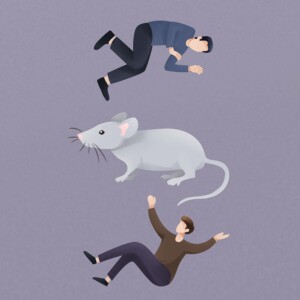
"Of Mice and Men" is a novella written by John Steinbeck, which was first published in 1937. The author, John Steinbeck, was born in 1902 in Salinas, California, an agricultural region. His experiences growing up in a rural, agrarian environment greatly influenced his work, providing him with insights into the lives of working-class Americans, a theme prominently reflected in his writings.
The context of "Of Mice and Men" is set during the Great Depression, a period of severe economic downturn that affected many people in the United States. The story reflects the harsh realities of the time, including widespread unemployment, poverty, and the struggle for survival. It explores themes such as loneliness, dreams, and the nature of human relationships, against this backdrop of economic hardship.
The novella traces the experiences of two displaced migrant ranch workers, George Milton and Lennie Small, who move from place to place in California in search of new job opportunities during the Great Depression in the United States. George is small and sharp, while Lennie is large and strong but has a mental disability. They dream of owning their own land, which symbolizes stability and self-sufficiency in a time when these were scarce commodities.
Steinbeck's depiction of the American dream and his deep empathy for the plight of the common man are central to the novella. He examines the destructive nature of loneliness, and the necessity of companionship, and also explores the cruel reality faced by marginalized individuals in a capitalistic society.
"Of Mice and Men" is also notable for its sparse, naturalistic style, which reflects the bleakness of the landscape and the stark realities faced by the characters. Steinbeck's approach combines a narrative simplicity with a complex moral and thematic structure, making the novella a critical and popular success. It has been frequently adapted into film, stage plays, and other formats, further testifying to its enduring legacy and relevance.
Steinbeck’s work, including "Of Mice and Men", often prompted readers and critics to reflect on social injustice and advocate for change, making him a significant figure in American literature with enduring influence on both literature and social thought.
Chapter 2 Analysis of Main Characters and PlotCertainly! "Of Mice and Men" by John Steinbeck is a novella set during the Great Depression, focusing on the lives of two itinerant workers in California who dream of a better life. Here are the key characters and main plot elements:
- George Milton: A small, smart man who takes care of Lennie. He dreams of owning his own piece of land but struggles with the realities of the Depression and the responsibility of looking after Lienne.
- Lennie Small: A large, strong man with a mental disability. He loves petting soft things but often accidentally harms animals and people because he doesn't know his own strength. His actions drive much of the plot.
- The Dream: Both George and Lennie share a dream of buying their own land, growing crops, and raising rabbits. This dream represents hope and a better life.
- The Job at the Ranch: The story begins when George and Lennie arrive at a new job on a ranch after fleeing from trouble in their previous job. On the ranch, they meet other characters each with their own dreams and struggles.
- Curley: The boss’s son, aggressive and confrontational, especially towards larger men, which puts him at odds with Lennie.
- Curley’s Wife: The only major female character who is never named in the book; she is lonely and seeks attention from the ranch workers, which causes significant tension and leads to tragic consequences.
- Candy: An older ranch hand who fears getting fired as he ages; he becomes interested in George and Lennie's dream and offers his life’s savings to join in.
- Crooks: A black stable hand, isolated because of his race, who initially scoffs at the dream of George and Lennie but momentarily fantasizes about joining them.
- The Tragic Climax: Lennie’s inability to control his strength eventually leads to a tragic incident involving Curley's wife, which escalates to an ultimate crisis for George and Lennie.
- The Conclusion: Faced with an impossible situation, George makes a life-altering decision to protect Lennie from a brutal mob led by Curley seeking vengeance.
These elements together weave a narrative exploring themes of friendship, isolation, the merciless nature of the American Dream, and the often harsh reality of human existence.
Chapter 3 Theme Exploration and Analysis“Of Mice and Men” by John Steinbeck, published in 1937, is a staple in American literature, noted for its powerful storytelling and profound themes capturing the struggles of ordinary people. Set during the Great Depression, the novella follows two drifters, George Milton and Lennie Small, as they work as farmhands in California, dreaming of owning a plot of land. The themes explored in the novella are a poignant depiction of the human condition, the nature of dreams, isolation, companionship, and societal attitudes. Here is a deeper exploration of these themes:
- The American Dream
One of the prominent themes in “Of Mice and Men” is the pursuit of the American Dream. George and Lennie harbor a dream of buying a small piece of land, growing their own crops, and raising animals — a dream that symbolizes freedom and self-sufficiency. This dream encapsulates not only their desire to escape the relentless cycle of labor but also their hope for a better future, free from economic hardships. The novel probes the feasibility of the American Dream, suggesting that societal structures and economic circumstances may indefinitely defer, if not altogether preclude, its realization.
- Loneliness and Companionship
Loneliness pervades the lives of several characters in the novel. Beyond George and Lennie, characters like Candy, Crooks, and Curley's wife all suffer from deep isolation and alienation, reflective of the fragmented society of the time. Each character's isolation is derived from various issues such as age, race, gender, and social status. The camaraderie between George and Lennie thus stands in stark contrast to the prevailing loneliness, highlighting the human need for companionship as essential for psychological survival.
- Strength and Weakness
The novella presents various forms of strength and weakness: physical strength, intellectual power, and emotional resilience. Lennie's great physical strength paired with his mental handicap forms a central paradox, endangering himself and those around him. Conversely, characters like George, who are not physically imposing, exhibit intellectual and emotional depth, often acting as protectors. The narrative critically addresses how societal norms equate strength with power and dominance, often at the expense of compassion and cooperation.
- The Role of Women
Women in “Of Mice and Men” are presented through a predominantly male lens, reflecting the gender biases of the time. Curley’s wife, the only prominent female character, is depicted as a source of trouble and temptation, often objectified and unnamed throughout the novella. Her dreams of becoming a movie star and escaping her disappointing marriage reflect a parallel form of confinement experienced by women, constrained by both their gender and their social roles.
- Nature and Fate
Nature imagery and fate play significant roles in contributing to the atmosphere and foreshadowing the plot's development. The settings often contrast the harsh lives of the characters with the natural beauty surrounding them, perhaps suggesting an indifferent universe. The recurrent references to animals and natural processes also remind readers of the inevitability of fate, symbolizing the larger forces at play over which individual characters have little control.
- Disability and Power
Steinbeck explores the dynamics of power related to disability through Lennie and other characters. Lennie's mental disability and the marginalization of other characters (like Crooks with his physical disability and Candy with his age-related limitations) reflect on how society views and treats those who are different. The often harsh treatment of these characters exposes not only the intolerance and cruelty of their world but also calls into question the true nature of power and its use in society.
Through these themes, "Of Mice and Men" portrays both the fragility and perseverance of human life, particularly highlighting the disenfranchised and marginalized individuals. Steinbeck’s portrayal invites readers to question and contemplate societal norms, the nature of human relationships, and the broader existential queries of purpose and destiny.
Book https://www.bookey.app/book/of-mice-and-men
Author https://www.bookey.app/quote-author/john-steinbeck
Quotes https://www.bookey.app/quote-book/of-mice-and-men
YouTube https://www.youtube.com/watch?v=2GJIDR9J5eg
Amazom https://www.amazon.com/Mice-Men-John-Steinbeck/dp/0140177396
Goodreads https://www.goodreads.com/book/show/890.Of_Mice_and_Men
More Episodes
 2024-07-17
2024-07-17
 22
22
 2024-07-16
2024-07-16
 19
19
 2024-07-13
2024-07-13
 17
17
 2024-07-12
2024-07-12
 13
13
 2024-07-12
2024-07-12
 8
8
 2024-07-11
2024-07-11
 17
17
 2024-07-10
2024-07-10
 19
19
Create your
podcast in
minutes
- Full-featured podcast site
- Unlimited storage and bandwidth
- Comprehensive podcast stats
- Distribute to Apple Podcasts, Spotify, and more
- Make money with your podcast
It is Free
- Privacy Policy
- Cookie Policy
- Terms of Use
- Consent Preferences
- Copyright © 2015-2024 Podbean.com






